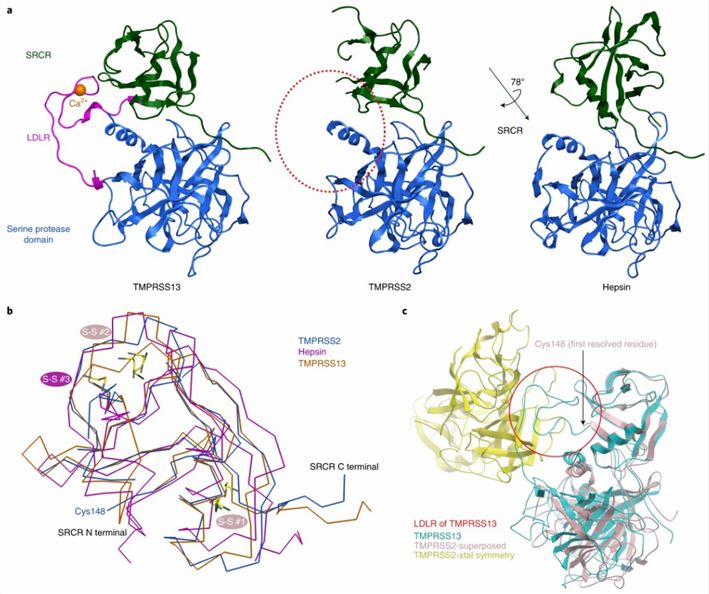What is TMPRSS2 Protein
In the intricate realm of human biology, the TMPRSS2 (transmembrane serine protease 2) protein plays a key role in coordinating various physiological processes.
TMPRSS2, encoded by the TMPRSS2 gene on chromosome 21, occurs as a transmembrane serine protease that is fine-tuned to regulate critical cellular processes. TMPRSS2 is mainly expressed in tissues such as the prostate, lung, and digestive system, and is important for physiological homeostasis and disease pathogenesis.
 Figure 1. The stem domain of TMPRSS2 is structurally similar to TMPRSS13 (Fraser, B.J., et al. 2022)
Figure 1. The stem domain of TMPRSS2 is structurally similar to TMPRSS13 (Fraser, B.J., et al. 2022)The Function of TMPRSS2 Protein
TMPRSS2 functions as a type II transmembrane serine protease, demonstrating its ability to cleave other proteins. This catalytic activity is central to the effects of TMPRSS2 on various physiological processes. Notably, the role of TMPRSS2 in proteolytic activation occupies a central position during viral entry.
Proteolytic activation of TMPRSS2 becomes particularly evident in promoting viral entry. In various viruses such as coronavirus, influenza virus, and respiratory syncytial virus, the participation of TMPRSS2 is indispensable. For coronaviruses like SARS-CoV-2, TMPRSS2 cleaves the viral spike protein, a key step in initiating fusion of the virus with the host cell membrane, thereby increasing the efficiency of viral entry.
TMPRSS2-Related Diseases
TMPRSS2 emerges as a key player in the pathology of various diseases, providing unique insights into infectious and non-infectious diseases. The fusion event of TMPRSS2 with the ERG gene in prostate cancer marks a major discovery. In a large number of prostate cancer cases, this fusion has been observed to lead to ERG overexpression and to promote the oncogenic process. Understanding TMPRSS2-ERG fusion events reveals new diagnostic and therapeutic avenues for prostate cancer.
TMPRSS2 Related Signaling Pathways
The functional complexity of TMPRSS2 is closely related to signaling pathways within the cellular environment. There is a noteworthy connection between TMPRSS2 and the androgen receptor (AR) signaling pathway, particularly in the context of prostate cancer and androgen regulation.
The expression of TMPRSS2 is regulated by androgens, showing a direct link to androgen receptor signaling. This interaction has important implications in diseases such as prostate cancer, where androgen deprivation therapy is a cornerstone of treatment strategies.
Applications of TMPRSS2 in Biomedical Research
The unique properties of TMPRSS2 make it a valuable target for a variety of biomedical applications ranging from diagnostics to therapeutic interventions.
- Diagnostic Biomarker
The unique regulation of TMPRSS2 in multiple diseases, including prostate cancer, makes it a potential diagnostic biomarker. Analyzing TMPRSS2 expression levels in tissues or body fluids could provide a non-invasive and precise diagnostic tool.
- Therapeutic Target
The role of TMPRSS2 in viral entry, particularly in the context of respiratory viruses such as SARS-CoV-2, has prompted interest in exploring inhibition of TMPRSS2 as a therapeutic strategy. Small molecules and inhibitors targeting TMPRSS2 offer a promising avenue for mitigating viral infections.
- Prostate Cancer Treatment
TMPRSS2-ERG fusion event is a hallmark of prostate cancer and open new prospects for targeted therapy. Drugs designed to specifically target this fusion or the downstream signaling pathways affected by TMPRSS2 represent a paradigm shift in prostate cancer treatment.
- Drug Development
Delving deeper into the structure and function of TMPRSS2 reveals a treasure trove of opportunities for drug development. In addition to infectious diseases and cancer, TMPRSS2's role in proteolytic activation suggests its potential as a target for novel therapeutics across multiple medical conditions.
TMPRSS2 was once a marginalized protein but is now critical to a variety of biological processes. As research into the structure, function, and biomedical applications of TMPRSS2 continues, the scientific community is expected to develop innovative diagnostic and therapeutic solutions that echo the precision of TMPRSS2 itself.
Recommended Products for TMPRSS2 Protein
| Cat.# | Species | Product name | Source (Host) | Tag |
|---|---|---|---|---|
| TMPRSS2-4595H | Human | Active Recombinant Human TMPRSS2 protein, His-tagged | Yeast | His |
| TMPRSS2-1856H | Human | Recombinant Human TMPRSS2 Protein (106-492 aa), His-tagged | Yeast | His |
| TMPRSS2-30144TH | Human | Recombinant Human TMPRSS2 | Wheat Germ | N/A |
| TMPRSS2-01H | Human | Recombinant Human TMPRSS2 protein | E.coli | |
| TMPRSS2-086H | Human | Recombinant Human TMPRSS2 Protein, His-tagged | Human cells | His |
| TMPRSS2-4597H | Human | Recombinant Human TMPRSS2 protein, His&Myc-tagged | Mammalian cell | His&Myc |
| TMPRSS2-13H | Human | Recombinant Active Human TMPRSS2 Protein (107-492), N-FLAG and C-Myc/His-tagged | HEK293F | N-FLAG and C-Myc/His |
| Tmprss2-8078M | Mouse | Recombinant Mouse Tmprss2 protein, His & T7-tagged | E.coli | His/T7 |
| Tmprss2-429R | Rat | Recombinant Rat Tmprss2 Protein, His-tagged | E.coli | N-His |
| TMPRSS2-1912Z | Zebrafish | Recombinant Zebrafish TMPRSS2 | Mammalian Cell | His |
Reference
- Fraser, B.J., et al. Structure and activity of human TMPRSS2 protease implicated in SARS-CoV-2 activation. Nat Chem Biol. 2022, 18: 963–971.

